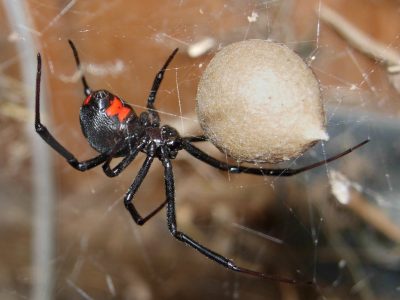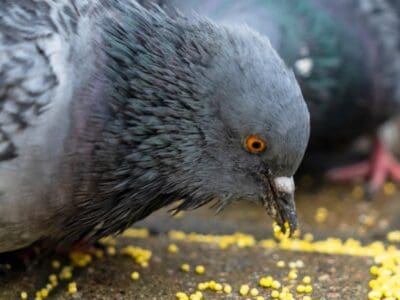Cricket
Acheta domesticus
Male crickets can produce sounds by rubbing their wings together
Advertisement
Cricket Scientific Classification
- Kingdom
- Animalia
- Phylum
- Arthropoda
- Class
- Insecta
- Order
- Orthoptera
- Family
- Gryllidae
- Genus
- Acheta
- Scientific Name
- Acheta domesticus
Read our Complete Guide to Classification of Animals.
Cricket Conservation Status
Cricket Facts
- Prey
- Fruit, leaves, grasses, flowers, seeds, and other insects
- Name Of Young
- Nymphs
- Group Behavior
- Solitary
- Fun Fact
- Male crickets can produce sounds by rubbing their wings together
- Most Distinctive Feature
- The long legs
- Gestation Period
- One or two weeks
- Litter Size
- Up to 100 eggs per day
- Habitat
- Grasslands, forests, swamps, mountains, and more
- Predators
- Spiders, reptiles, frogs, birds, small mammals, and insects
- Diet
- Omnivore
- Type
- insect
- Common Name
- cricket
- Number Of Species
- 2400
View all of the Cricket images!
Fried crickets are a delicacy in Thailand.
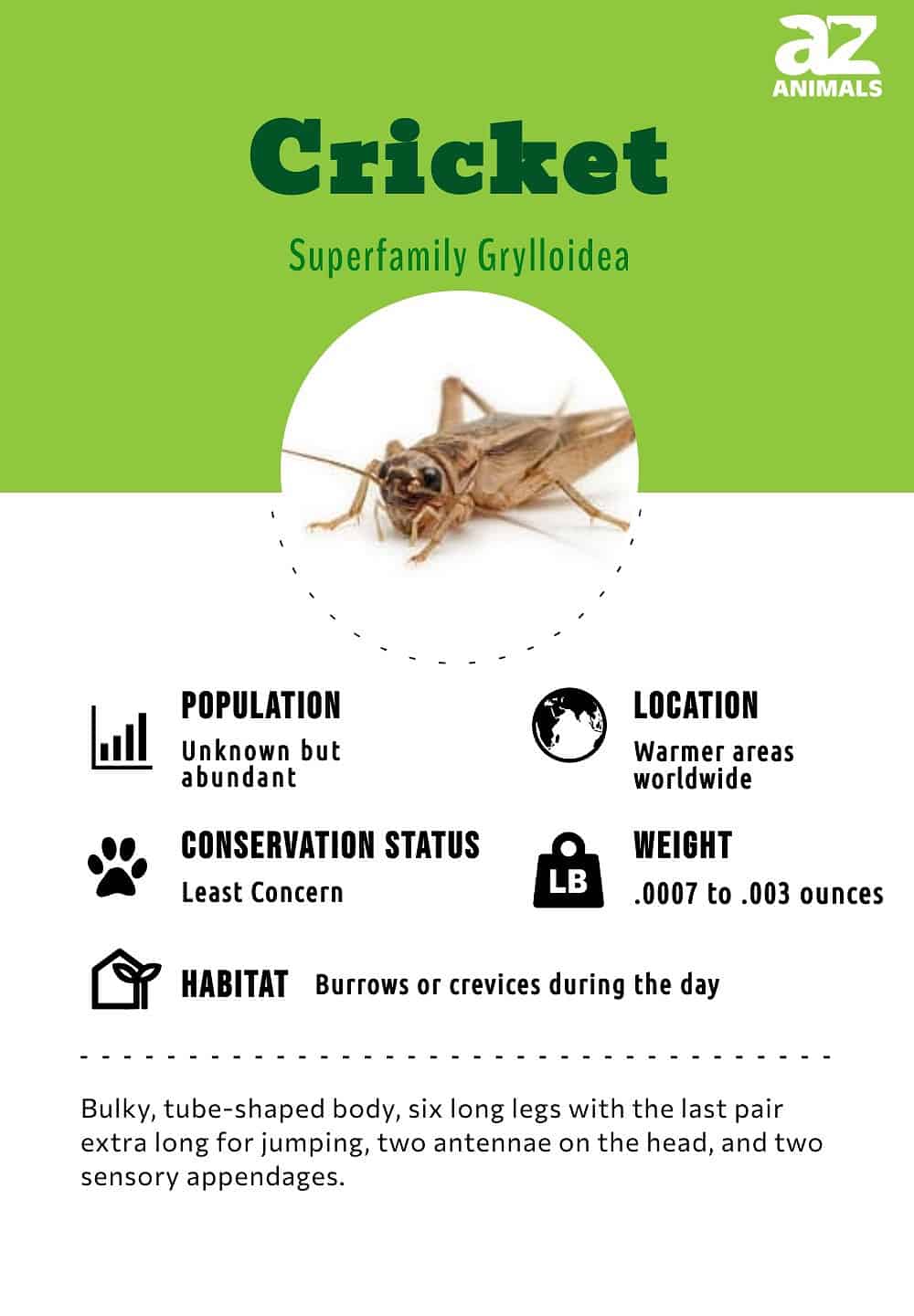
Crickets are some of the noisiest insects on the planet. The sound of the male fills the spring and summer night air, which for some people might be soothing but for others annoying. The purpose of the chirping noise is to attract a potential mate or repel male rivals. Many people confuse them with grasshoppers, but in fact, they share only a distant relationship.
4 Incredible Facts!
- Male crickets produce their chirping noises by rubbing their wings together (grasshoppers rub their legs together). The soft leathery sound-producing organ, located directly on the forewing, is rubbed against rows of about 50 to 250 teeth on the opposite forewing.
- The exact frequency of the sound, which depends on how many teeth are struck, can range between 1,500 and 10,000 cycles per second.
- The cricket’s jumping ability is particularly amazing. It can leap a few feet up into the air, which, given its small body size, is an impressive feat. The wings also provide very limited flight over small areas.
- Crickets are considered to be a sign of good luck and fortune in many cultures. Some people keep them as pets, but they’ve also been used for sport. Cricket fighting is a traditional Chinese custom that dates back more than a thousand years.
Scientific Name
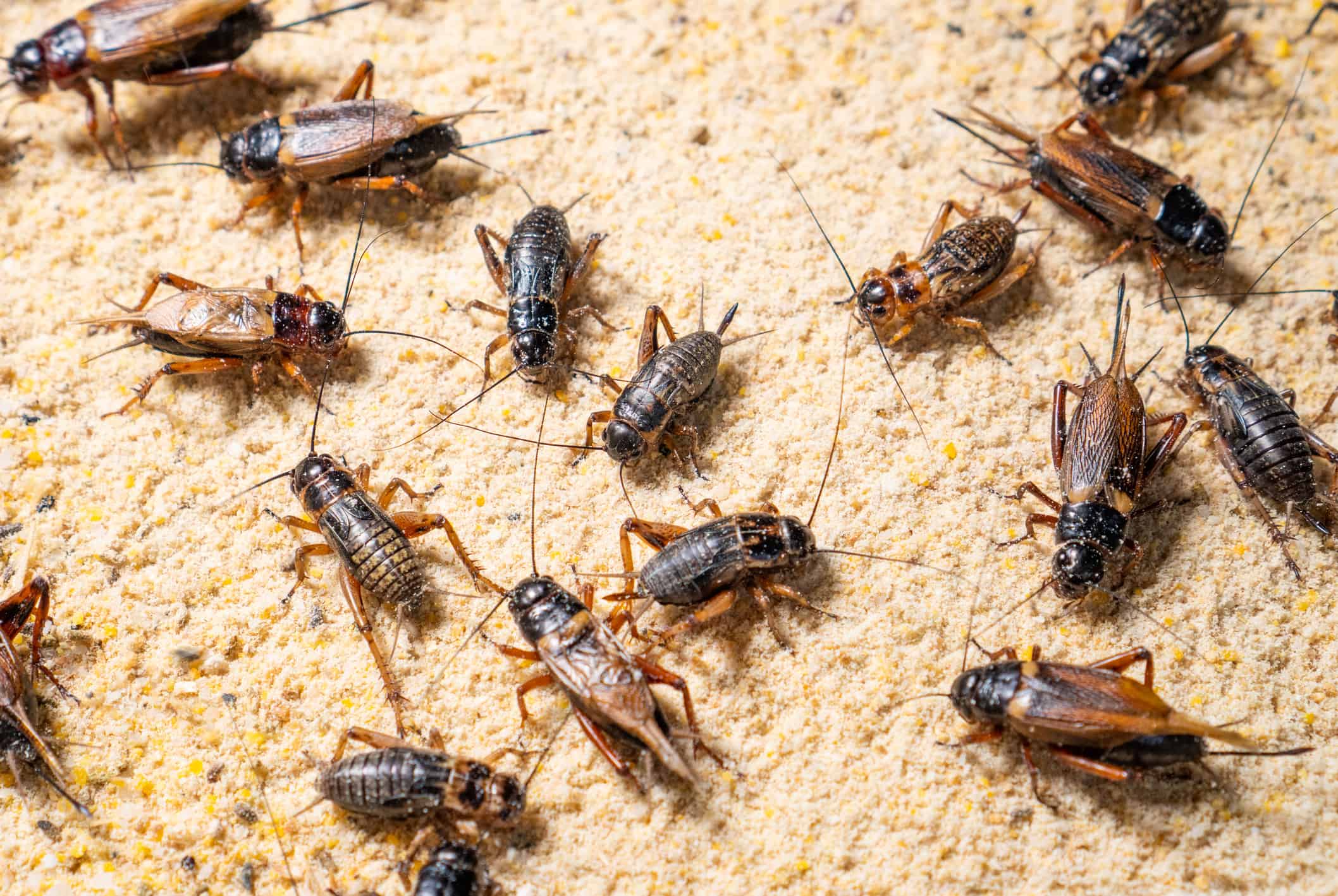
Field crickets, one of the many types of crickets, are darker and smaller.
©iStock.com/amnat jomjun
Crickets are in the Class Insecta, Order Orthoptera, Suborder Ensifera, Infraorder Gryllidea, and Superfamily Grylloidea. The superfamily Grylloidea was once considered just a family, but scientists have now changed that classification. The name comes from the Latin word gryllus for cricket. However, there are many related species, including the scaly spider and a number of insects with “cricket” in their names (e.g., mole cricket, camel cricket, Jerusalem cricket) that are not considered to be “true” crickets, but they do share many similarities. Altogether, there are some 2,400 known species. The most common of the true crickets in Europe is the house cricket (Acheta domesticus).
Appearance
Identification is fairly simple. The cricket is a relatively large insect with a bulky tube-shaped body, measuring up to an inch or two in length. Important features include six very long legs (each of which contains three joints), the two long antennae extending from the head, and two sensory appendages (called cerci) on the back of the abdomen. The last pair of legs is particularly long to help with jumping.
Most species are capable of at least some basic flight, but some ground crickets are not capable of flight at all. The wings are mostly adapted to attract mates. The vast majority of species are colored brown and black, but some are covered in green and red as well. The nymphs look like small, undeveloped versions of the full adult form.
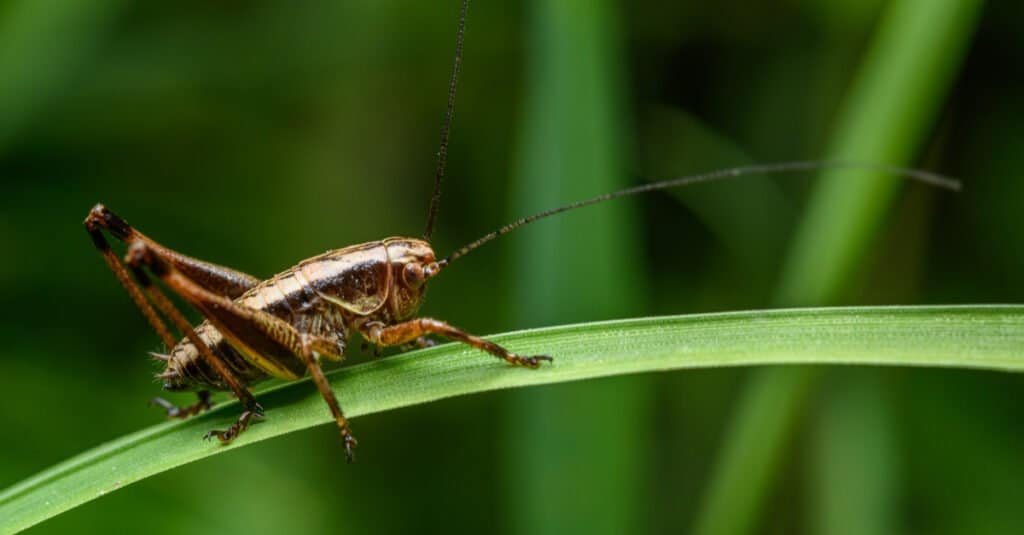
©iStock.com/Petr Ganaj
Habitat
Crickets are found in nearly all of the world’s habitats except for the extreme north and south. They spend most of the day hidden in cracks, leaves, bark, stones, and logs, and then they often come out into the open at night. Mole crickets create burrows in the ground with their mole-shaped hands.
Predators and Prey
Crickets are preyed upon by numerous predators, including spiders, lizards, geckos, turtles, frogs, birds, small mammals, other insects, and even fungi. Some parasitoid insects will prey upon crickets by laying their legs on its body. Once the larvae hatch, they will consume the entire cricket whole while it’s still alive. Camouflage provides a degree of protection against most predators. If that fails, then they will often try to hide in narrow crevices.
Crickets are omnivorous insects, but most of what they eat is plant matter. Some species will consume fruits, leaves, flowers, grasses, seeds, fungi, and other bits of organic matter. Other predatory species will also consume insects and other invertebrates.
Reproduction and Lifespan
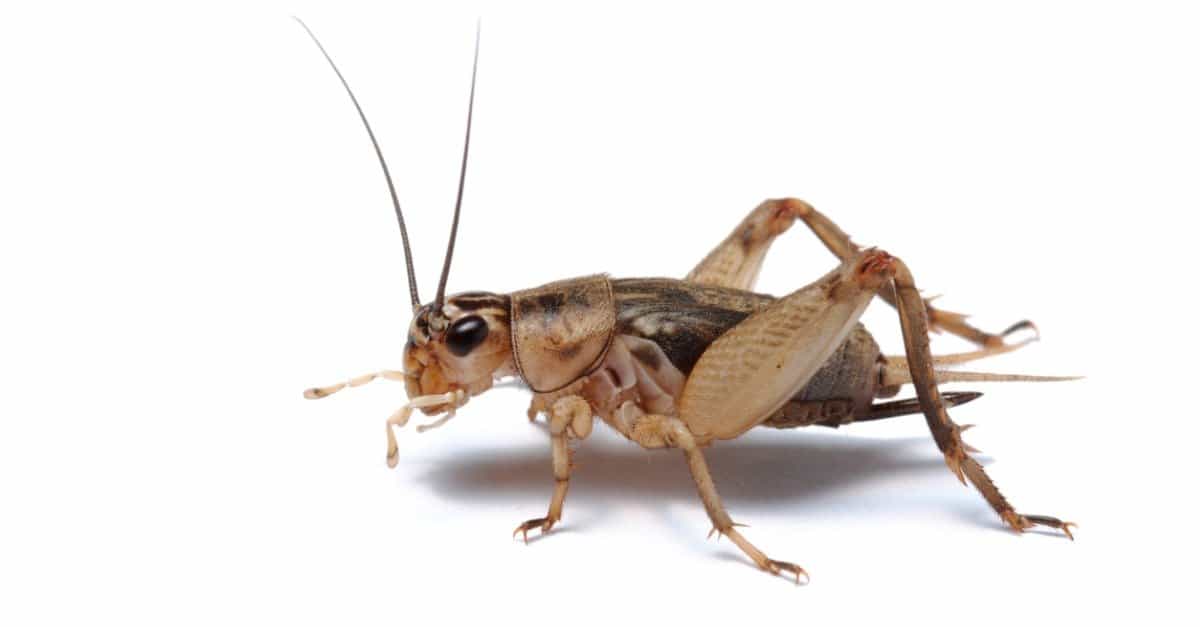
Male and female crickets have a special auditory organ on their forelegs that lets them hear chirps.
©iStock.com/PetrP
A male cricket will make its chirping sound to attract a mate. Male and female crickets have a special auditory organ on their forelegs that lets them hear the chirps.
During copulation, male crickets will transfer a spermatophore (protein capsule containing sperm) through a genital opening in the female into a single sperm reservoir. The female will then lay eggs through a long needlelike organ called the ovipositor.
The cricket undergoes three distinct stages: egg, nymph, and adult. Females lay the eggs in soil or plant stems along the ground in the fall. After hatching in the spring, the nymphs grow progressively larger after each one of the six to 12 molts. The adults have a normal lifespan of just a few months.
Prevention
Crickets do not generally pose a direct threat to people, but their digging in the soil can sometimes cause a bit of damage to lawns and gardens. Field and house crickets can also take refuge in homes and buildings when the temperature drops outdoors. To remove them from your property, you should apply some insecticide by following the instructions on the package. A mixture of dish soap and water applied to the soil may cause any hidden underground mole crickets to surface. Keeping your grass trim, draining gutters or standing water, removing any debris, and repairing any holes in your home can help to prevent an infestation.
To take care of an infestation in your home, there are a few things you can do. You can apply an insecticide bug spray to the windowsills and corners of your home (though you will need to wait for the insecticide to dry before allowing children and pets into the room). For an alternative non-toxic solution, you can apply a substance called diametaceous earth to baseboards and wall cervices around the home. Finally, you can place baits and traps in areas where the insects have been spotted. While many stores do sell traps, you can also create natural bait on your own by placing a tiny bit of molasses in a shallow bowl filled partly with water. The cricket may be tempted to jump in the bowl where it will drown. Fortunately, the cricket is a fairly benign insect and doesn’t cause too many problems.
View all 235 animals that start with CCricket FAQs (Frequently Asked Questions)
What is a cricket?
The cricket is a large jumping insect that also makes a loud chirping noise. Some of the most common types include field and house cricket.
Are crickets dangerous?
No, they are not dangerous, but they can cause some minor damage to the soil.
How many legs does the cricket have?
Like all other insects, it has six legs in total. The last pair is particularly large and enhanced to assist with jumping.
How do you identify crickets?
Identification isn’t too difficult. This insect is usually characterized by the long, tube-shaped bodies, long antennae, and extended back legs. Most species have a basic set of wings to help with flight and attract a mate. If the insect leaps into the air, then it might be a sign you’re dealing with a cricket.
How do you get rid of crickets?
Insecticides, traps, baits, and non-toxic chemical treatments are usually the best way to get rid of them.
How do I stop the cricket sound?
The males produce sounds naturally at night, and it would be very difficult to stop the chirping without clearing the entire nearby area with insecticides. If the sound is coming from inside of your home, then you should follow the instructions previously mentioned to get rid of them.
What is the largest cricket?
The largest type is the bull cricket, which measures about 2 inches long.
Are crickets harmful to humans?
They are almost completely harmless to people.
What causes crickets in the house?
Field and house crickets will seek refuge in a warm building when the temperature drops outside. Sealing any holes and taking care of debris or stagnant water outside is an important part of prevention.
Why do crickets only make noise at night?
This is because they are actually nocturnal animals. They sleep during the day and come out at night. Some species do make noises during the day, but it’s less common.
Thank you for reading! Have some feedback for us? Contact the AZ Animals editorial team.
Sources
- Britannica, Available here: https://www.britannica.com/animal/cricket-insect









